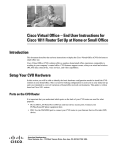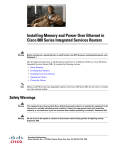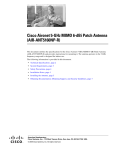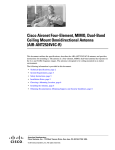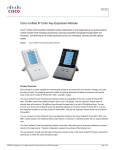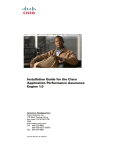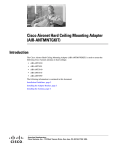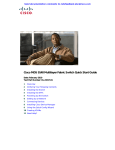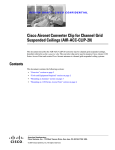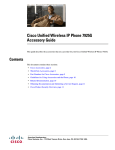Download Cisco Aironet 2.4 GHz
Transcript
Cisco Aironet 5-dBi Diversity Omnidirectional Antenna (AIR-ANT2452V-R) This document outlines the specifications for the Cisco Aironet 5-dBi Diversity Omnidirectional Antenna (AIR-ANT2452V-R) and provides instructions for mounting it. The antenna operates in the 2.4 GHz frequency range and is designed for indoor use. The following information is provided in this document. • Technical Specifications, page 2 • System Requirements, page 3 • Safety Precautions, page 3 • Installation Notes, page 4 • Installing the Antenna, page 4 • Obtaining Documentation, Obtaining Support, and Security Guidelines, page 9 Americas Headquarters: Cisco Systems, Inc., 170 West Tasman Drive, San Jose, CA 95134-1706 USA © 2009 Cisco Systems, Inc. All rights reserved. Technical Specifications Technical Specifications Antenna type Diversity Omnidirectional Operating frequency range 2400 MHz - 2500 MHz VSWR < 2:1 Gain 5 dBi Polarization Linear, Vertical Elevation Plane Beamwidth 27 degrees Azimuth Plane Beamwidth 360 degrees Length 11 in. (27.24 cm) Width 5 in. (12.7 cm) Depth 1 in. (2.54 cm) Environment Indoor Cable length and type Conjoined Plenum Rated 36 in. Connector RP-TNC plug Operating temperature -22 to 167 F (-30 C to +75 C) Azimuth and Elevation Radiation Patterns Azimuth and Elevation Radiation Patterns Cisco Aironet 5-dBi Diversity Omnidirectional Antenna (AIR-ANT2452V-R) 2 78-19009-01 System Requirements System Requirements This antenna is designed for indoor use with any 2.4-GHz Cisco Aironet radio device that uses a RP-TNC connector. Safety Precautions Translated versions of the following safety warnings are provided in the Safety Warnings for Cisco Aironet Antennas, which is available at http://cisco.com. Warning Installation of this antenna near power lines is dangerous. For your safety, follow the installation directions. Each year hundreds of people are killed or injured when attempting to install an antenna. In many of these cases, the victim was aware of the danger of electrocution but did not take adequate steps to avoid the hazard. For your safety, and to help you achieve a good installation, please read and follow these safety precautions. They may save your life! 1. If you are installing an antenna for the first time, for your own safety as well as others, seek professional assistance. Your Cisco sales representative can explain which mounting method to use for the size and type antenna you are about to install. 2. Select your installation site with safety as well as performance in mind. Remember: electric power lines and phone lines look alike. For your safety, assume that any overhead line can kill you. 3. Call your electric power company. Tell them your plans and ask them to come look at your proposed installation. This is a small inconvenience considering your life is at stake. 4. Plan your installation carefully and completely before you begin. Successful raising of a mast or tower is largely a matter of coordination. Each person should be assigned a specific task, and should know what to do and when to do it. One person should be in charge of the operation to issue instructions and watch for signs of trouble. 5. When installing your antenna, remember: a. Do not use a metal ladder. b. Do not work on a wet or windy day. c. Do dress properly—shoes with rubber soles and heels, rubber gloves, long sleeved shirt or jacket. 6. If the assembly starts to drop, get away from it and let it fall. Remember, the antenna, mast, cable, and metal guy wires are all excellent conductors of electrical current. Even the slightest touch of any of these parts to a power line completes an electrical path through the antenna and the installer: You! 7. If any part of the antenna system should come in contact with a power line, don’t touch it or try to remove it yourself. Call your local power company. They will remove it safely. 8. If an accident occurs with the power lines, call for qualified emergency help immediately. Cisco Aironet 5-dBi Diversity Omnidirectional Antenna (AIR-ANT2452V-R) 78-19009-01 3 Installation Notes Installation Notes Antennas transmit and receive radio signals which are susceptible to RF obstructions and common sources of interference that can reduce throughput and range of the device to which they are connected. Follow these guidelines to ensure the best possible performance: • Install the antenna vertically and mount it as high as possible. • Keep the antenna away from metal obstructions such as heating and air-conditioning ducts, large ceiling trusses, building superstructures, and major power cabling runs. If necessary, use a rigid conduit to lower the antenna away from these obstructions. • The density of the materials used in a building’s construction determines the number of walls the signal can pass through and still maintain adequate signal strength. Consider the following before choosing the location for your antenna: – Signals penetrate paper and vinyl walls with little change to signal strength. – Signals penetrate only one or two solid and pre-cast concrete walls without degrading signal strength. – Signals penetrate three or four concrete and wood block walls without degrading signal strength. – Signals penetrate five or six walls constructed of drywall or wood without degrading signal strength. – Signals will likely reflect off a thick metal wall and may not penetrate it at all. – Signals will likely reflect off a chain link fence or wire mesh spaced between 1 and 1 1/2 in. (2.5 and 3.8 cm). The fence acts as a harmonic reflector that blocks the signal. • Install the antenna away from microwave ovens and 2-GHz cordless phones. These products can cause signal interference because they operate in the same frequency range as the device to which your antenna is connected. Choosing a Mounting Location The antenna should be mounted clear of any obstructions to the sides of the radiating elements. Generally, the higher an antenna is above the floor, the better it performs. If possible, find a mounting place directly above your wireless device to ensure the lead-in cable can be as short as possible. Installing the Antenna You can install the antenna on any flat vertical surface or on a pole. All hardware for mounting the antenna on a wall is provided. If you intend to install your antenna on another surface, you must provide the appropriate hardware. Tools and Equipment Required A mounting installation kit is included with the antenna and consists of the following hardware: • Antenna bracket • One 1/4 –20 cap screw Cisco Aironet 5-dBi Diversity Omnidirectional Antenna (AIR-ANT2452V-R) 4 78-19009-01 Installing the Antenna • One flat washer • One screen mesh washer • One spherical washer • One wing bolt • Mounting bracket • Wall bracket • Four #8 x ¾ in. screws You may need the following tools and equipment, which are not provided. • A #2 Phillips screwdriver • A drill and drill bit • A pencil • Two hose clamps Mounting on a Vertical Surface Follow these steps to mount your antenna on a vertical surface. Step 1 Attach the antenna bracket to the antenna using the 1/4 – 20 cap screw and flat washer provided (Figure 1). Figure 1 Step 2 Antenna Bracket With the screen mesh washer between the two brackets, attach the antenna bracket to the mounting bracket using the spherical washer and wing bolt provided (Figure 2). Cisco Aironet 5-dBi Diversity Omnidirectional Antenna (AIR-ANT2452V-R) 78-19009-01 5 Installing the Antenna Figure 2 Antenna Bracket Attached to Mounting Bracket Step 3 Determine the mounting location for the antenna. Step 4 Attach the wall bracket to the wall using the two screws provided (Figure 3). Figure 3 Step 5 Wall Mounting Slide the mounting bracket onto the wall bracket and secure it in place (optional) with the two screws provided (Figure 4). Cisco Aironet 5-dBi Diversity Omnidirectional Antenna (AIR-ANT2452V-R) 6 78-19009-01 Installing the Antenna Figure 4 Attaching Mounting Bracket to Wall Bracket Once the antenna is secured on the wall, you can adjust the azimuth and elevation. Step 6 To adjust the azimuth and elevation, loosen the bolt that attaches the antenna bracket to the mounting bracket (Figure 5). Azimuth can be adjusted ±90 degrees. Elevation can be adjusted +15 degrees and -35 degrees. Figure 5 Azimuth and Elevation Adjustment Cisco Aironet 5-dBi Diversity Omnidirectional Antenna (AIR-ANT2452V-R) 78-19009-01 7 Installing the Antenna Mounting on a Mast The antenna can be mounted on a mast rather than on a wall using two 1/2 inch-wide hose clamps (not provided). To mount the antenna on a mast, follow these steps: Step 1 Follow Step 1 and Step 2 from “Mounting on a Vertical Surface”. Step 2 Position the antenna, mounting bracket, and hose clamps on the mast. Step 3 Tighten the hose clamps until the antenna is secure on the mast. Once the antenna is secured on the mast, you can adjust the azimuth and elevation. Step 4 To adjust the azimuth and elevation, loosen the bolt that attaches the antenna bracket to the mounting bracket (Figure 5). Azimuth can be adjusted ±90 degrees. Elevation can be adjusted +15 degrees and -35 degrees. Suggested Cable Cisco recommends a high-quality, low-loss cable for use with the antenna. Note Coaxial cable loses efficiency as the frequency increases, resulting in signal loss. The cable should be kept as short as possible because cable length also determines the amount of signal loss (the longer the run, the greater the loss). Each antenna terminates with a RP-TNC plug after a short, 3-ft (0.91-m) cable. The mating connector to the antenna is an appropriate RP-TNC jack. The connector on the opposite end will vary according to the type of equipment used. Cisco Aironet 5-dBi Diversity Omnidirectional Antenna (AIR-ANT2452V-R) 8 78-19009-01 Obtaining Documentation, Obtaining Support, and Security Guidelines Obtaining Documentation, Obtaining Support, and Security Guidelines For information on obtaining documentation, obtaining support, providing documentation feedback, security guidelines, and also recommended aliases and general Cisco documents, see the monthly What’s New in Cisco Product Documentation, which also lists all new and revised Cisco technical documentation, at: http://www.cisco.com/en/US/docs/general/whatsnew/whatsnew.html CCDE, CCENT, Cisco Eos, Cisco HealthPresence, the Cisco logo, Cisco Lumin, Cisco Nexus, Cisco StadiumVision, Cisco TelePresence, Cisco WebEx, DCE, and Welcome to the Human Network are trademarks; Changing the Way We Work, Live, Play, and Learn and Cisco Store are service marks; and Access Registrar, Aironet, AsyncOS, Bringing the Meeting To You, Catalyst, CCDA, CCDP, CCIE, CCIP, CCNA, CCNP, CCSP, CCVP, Cisco, the Cisco Certified Internetwork Expert logo, Cisco IOS, Cisco Press, Cisco Systems, Cisco Systems Capital, the Cisco Systems logo, Cisco Unity, Collaboration Without Limitation, EtherFast, EtherSwitch, Event Center, Fast Step, Follow Me Browsing, FormShare, GigaDrive, HomeLink, Internet Quotient, IOS, iPhone, iQuick Study, IronPort, the IronPort logo, LightStream, Linksys, MediaTone, MeetingPlace, MeetingPlace Chime Sound, MGX, Networkers, Networking Academy, Network Registrar, PCNow, PIX, PowerPanels, ProConnect, ScriptShare, SenderBase, SMARTnet, Spectrum Expert, StackWise, The Fastest Way to Increase Your Internet Quotient, TransPath, WebEx, and the WebEx logo are registered trademarks of Cisco Systems, Inc. and/or its affiliates in the United States and certain other countries. All other trademarks mentioned in this document or website are the property of their respective owners. The use of the word partner does not imply a partnership relationship between Cisco and any other company. (0812R) Cisco Aironet 5-dBi Diversity Omnidirectional Antenna (AIR-ANT2452V-R) 78-19009-01 9









